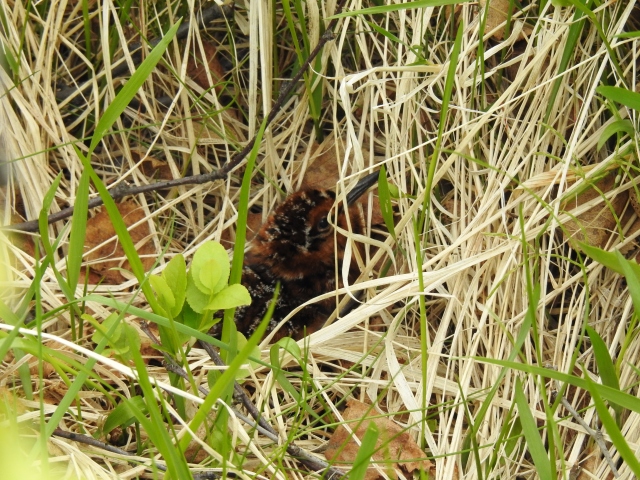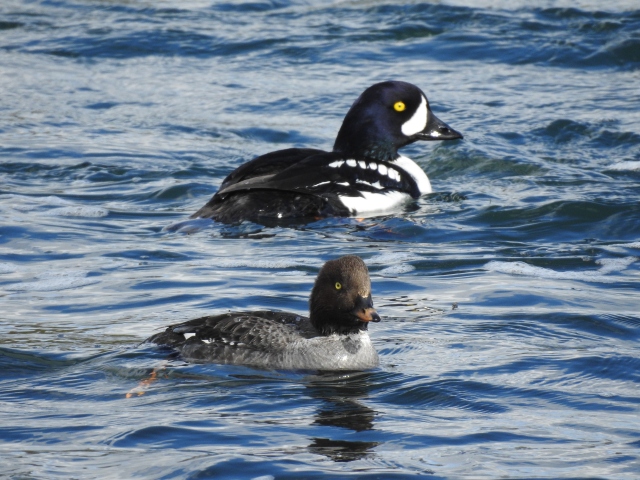I’ve not written anything here for a while now, and once again it is a holiday abroad that has tempted me back! We spent a week in Iceland at the end of May and below is a brief summary of the best bits, focusing, of course, on the wildlife.
Depending on which book/website you read, there are between 75 and 85 breeding birds in Iceland. We visited near the start of the breeding season and were very pleased with our final total of 68 species, the final two being added on our last day in the north when we found Goldcrest and Wren in a Birch forest on the way to the airport at Akureyri. The most obvious difference between birding in the UK and birding in Iceland is the almost complete lack of songbirds in the latter. Having said that, I was woken on our first morning at our hotel in Husafell by a small chorus of birds singing and I really couldn’t work out what they were until I went outside and found one of them. They were Redwings – a bird I see every winter in Suffolk but have never heard sing.
Favourite place
All three of us agreed that our favourite place in Iceland was Hrisey Island, which is situated in the middle of a giant fjord in the north. And to think we nearly didn’t go there! When we woke in our hotel in Siglufjordur (even further north – the most northerly town in Iceland in fact) it was snowing outside, clouds were hiding most of the mountains and the temperature was only a degree or so above freezing. We had also had a very long drive the day before, but in the end we decided to do the 45 minute drive to Arskogsandur and the 20 minute ferry from there to the island. The main reason for the decision was our spectacular failure to find Ptarmigan (even though they are allegedly all over Iceland) – and Hrisey has the highest concentration of them anywhere in Iceland. And it did not disappoint …

It was Tom who spotted our first Ptarmigan – he said he was just walking along thinking there really should be a Ptarmigan on one of the small grassy hillocks beside the path, and suddenly – there was! Finding this bird was also one of our favourite moments of the whole holiday.

Hrisey isn’t just about Ptarmigan though. There was a lovely walk that took a little under 3 hours and that covered several habitat types including a pond, cliffs, heathland and a small village. One of my favourite birds – the Fulmar – could be seen over the cliffs and several flew so close that we could almost touch them. The ones on the cliff didn’t seem at all bothered by our presence either.

Another common bird on Hrisey (and indeed all over Iceland) is the Snipe. Almost every bird seen from the car turned out to be a Snipe flying up into the air before descending whilst making its drumming noise with its tail feathers. On Hrisey though, we came as close as we ever will to a Snipe – Tom was in the lead (as usual) and almost stepped on the bird which flew up into a small tree. Tom looked down to where it had flown from and found this unbelievably cute little chap:

Don’t worry – we only took one photo and then quickly left so that the parent could come straight back to it.
I mentioned the small village as one of the “habitats” and in fact the village was where we got our best ever views of Snow Bunting. One of the birds was incredibly tame, not even flying off from its perch on top of a sign when a man walked over and removed his bike from just below.

The island also provided our first good views of an Arctic Skua chasing an Arctic Tern forcing it to give up its food. The Skua caught the abandoned food in the air before flying off over the cliffs. We saw Arctic Skua in several locations around Iceland, both on the ground and in the air (and once from our hotel room), but this was the best view of its kleptoparasitic behaviour. I didn’t even need to look that word up. Impressive eh?

Finally for the island – Redpolls. These are reasonably hard to see in Suffolk although we do find them most winters. It was nice to see them in breeding plumage, but the only one that stayed still enough to photograph wasn’t exactly looking his best.

Favourite birds
There were five birds that we were really hoping to see in Iceland, partly because we’d never seen them before, and partly because Iceland is the only place in Europe where you can easily find most of them. One of these I’ll save for later. Another was the Brunnich’s Guillemot and we found a group of these on the cliffs on the most westerly point of the Snaefellsjokull peninsula – they aren’t that exciting to look at though as they basically look like our Guillemot but with a shorter beak and a white facial stripe.
There were two ducks on the list – both of which are stunners and both of which are easily found on the Laxa river which flows from Lake Myvatn. The short walk along this stretch of river was probably our second favourite place in Iceland, and the birds are incredibly tolerant of people walking close to the water where they are sitting. There was also no-one else there at all! The first of these ducks is the Harlequin Duck which we saw in several coastal locations as well as Lake Myvatn.

The second is the Barrow’s Goldeneye which looks a bit like the Goldeneye that winters on the Stour estuary at home, until you look closely at it and you realise it is actually quite different and even better-looking.

The fourth bird on our “most wanted” list was the Ptarmigan which, as noted above, we finally found on Hrisey Island. And you’ll have to wait a bit longer to find out about the fifth bird which was arguably the most wanted of them all.
Favourite moments
We all had different favourite moments, some of which have already been described above, and one that will be described at the end. But the moment when a parent Red-necked Phalarope brought its young bird over to the river bank where we were standing and then just stood next to it, preening itself, right at our feet will live long in my memory. They didn’t even care if I reached over them and took a photo on my mobile phone. We’ll never get a better view than this of these tiny but incredibly coloured birds, and I felt privileged that they didn’t perceive us as a threat.


Favourite other wildlife
This was quite an easy category to judge – Iceland has no butterflies, no dragonflies and hardly any land mammals other than the Arctic Fox which we were highly unlikely to see. I think the list of other animals that we saw on land included one bumblebee and one moth – both unidentified to species level – and a rather large number of flies. However, a boat-trip from Husavik did allow us to see another three species including one BIG surprise. We were expecting to see Humpback Whales from the boat and we duly did, although not as close-up as we’d seen them in Nova Scotia. We were also treated to a pod of 15 to 20 White-beaked Dolphins travelling alongside the boat for several minutes. Our boat then headed quite a long way from Husavik without stopping – the crew clearly knew something that we didn’t. The guide gave a hint that the spout we’d seen ahead belonged to a large whale, but it was still quite a surprise when he announced that the whale that had just surfaced next to the boat was a Blue Whale. By this time both Tom and Jessica were sat at the rear of the boat, neither looking particularly perky. They both jumped to their feet at the announcement though, and although Jessica immediately sat down again, Tom at least made it to the front in time to sea the whale on the surface.
I do find seeing whales feeding a little underwhelming sometimes, and photos of them even more so. Which is why I didn’t take any. But still – we’ve now seen (a little bit of) the largest animal on the planet.
Lake Myvatn deserves a mention in this section thanks to the completely ridiculous number of flies that were present in certain areas. There were sections of one walk where opening our mouths to speak risked ending our vegetarianism on the spot. But the Lake was well worth visiting for its birdlife and there were many areas with no flies at all. We saw some fantastic Great Northern Divers on the lake, and also many Slavonian Grebes, or “Horned Grebe” as they call them in Iceland and elsewhere – a good name for it as I hope this photo shows.

And finally …
The biggest falcon in the world is the Gyrfalcon and in Europe it is only really found in Iceland, Greenland (we can argue about whether Greenland is part of Europe another time) and northern Scandinavia. It was a bird we really really wanted to see. It is significantly bigger than our Peregrine Falcon and we’d kept a careful eye out all week to try and find one – but with no luck. On our last night before flying back to Rekjavik, we sat down to dinner in a restaurant on the other side of Lake Myvatn to our hotel, and felt a little sad that this was the one bird we’d not seen. After leaving the restaurant we had the choice of going round the lake clockwise or anti-clockwise and chose the latter. It was a lovely evening – cold but reasonably bright – and there were (as usual) almost no cars on the road. As we went round a bend I saw yet another rock whose top was shaped a bit like a bird of prey, and even though I’d pointed out many of these during the day, I slowed the car slightly and suggested to Tom he might like to check it out. Seconds later, the words “Oh my god” came out of Tom’s mouth, the brakes were slammed on (no traffic remember!) and we’d stopped in the middle of the road to look at a Gyrfalcon on top of a rock about 50 metres away. It stared right back at us for a while, before standing up, pooping in a derogatory way, and then sitting back down again. At this point a car appeared in the rear view mirror, so we moved up the road a bit and parked on the side in the hope of walking back for further views. However just after leaving the car, the Gyrfalcon took off and we watched it fly very low over the ground towards the nearest mountain. I’ve never seen a bird look so muscular in flight as this one.
We spent the rest of the evening starting every sentence with “I can’t believe it …”. Iceland certainly saved its best to last!
